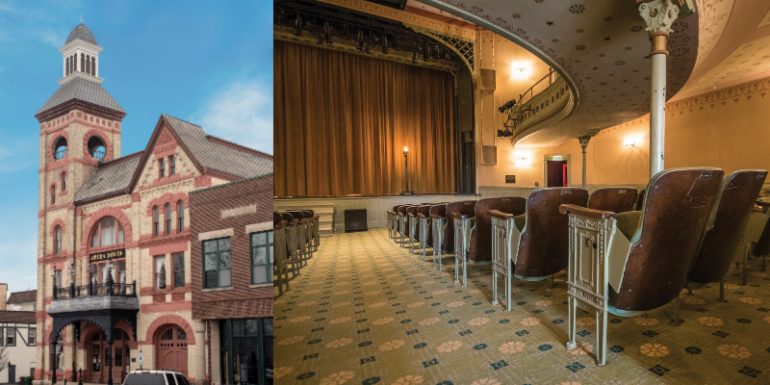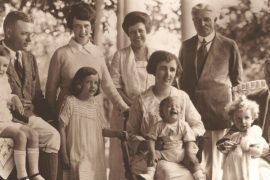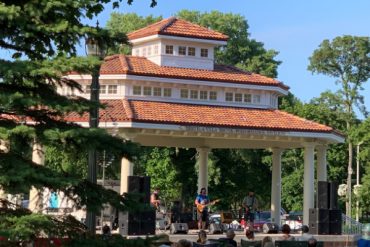By Anne Morrissy | Photography by Holly Leitner
Jane Addams spoke from its stage. Orson Welles performed there. So did Paul Newman, who reportedly slept backstage after the performance. In the 1990s, Bill Murray and Andie MacDowell bickered in front of it. For 130 years, the Woodstock Opera House in nearby McHenry County, Illinois, has drawn headliners from far and wide — speakers, musicians, vaudeville acts, thespians, students, athletes, professors and more.
“Woodstock in general has always been an arts town,” explains Daniel Campbell, managing director of the Woodstock Opera House. “There’s been a rather significant music and visual art scene here, and our theater scene has been extremely active ever since the Opera House opened in 1890. We’re one of the oldest continuously operating theaters in the country.”
Thanks to a massive, volunteer-led restoration campaign in the 1970s and a new addition in 2003, today the Opera House is more than merely an operating theater, it is a thriving theater. In 2019, the historic space hosted more than 800 events, including performances, movies, panels, rehearsals, meetings, and civic and private events.
In the modern era, as the downtowns of many small cities in the Midwest struggle to attract visitors and businesses, Woodstock’s idyllic downtown square — made famous to an entire generation when it served as a stand-in for Punxsutawney, Pennsylvania, in the 1993 movie “Groundhog Day” — continues to flourish, and the Woodstock Opera House contributes significantly to the ongoing downtown activity. The story of how the small city of Woodstock, Illinois (population 24,770 at the last census), first attracted and has maintained such a vibrant art, theater and cultural scene is rooted in a truly community-wide effort, one that is centered around the historic Woodstock Opera House.
A CITY COMMITTED TO ART
In 1888, Woodstock had been an incorporated city for just 15 years when a handful of aldermen expressed an ambition to construct a city hall that would serve several roles for the community. In the basement and on the first floor, they envisioned space for meeting rooms and city hall offices, a public library, and the police and fire departments. On the second floor, they planned an auditorium that could be used for civic meetings as well as performances and exhibitions.
The city leaders arranged to purchase a site on the downtown square for the new building’s construction. The land had remained empty since a fire had ravaged sections of downtown Woodstock 17 years earlier, on the same night the Great Chicago Fire ignited 60 miles to the southeast. They hired Elgin architect Smith Hoag to design the new building, and his plans included a rustic Romanesque exterior of brick, sandstone and terra cotta, featuring a tower rising 90 feet into the air. Hoag’s design for the interior of the theater on the second floor evoked a steamboat theater of the era, with a large horseshoe-shaped balcony, heavy curtains, Corinthian columns and intricately painted stenciling on the walls and ceilings.
Construction took a little more than a year, and on September 2, 1890, the City of Woodstock dedicated City Hall, the building that would eventually come to be known as the Woodstock Opera House. The Patti Rosa Company’s staging of “Margery Daw” became the first performance on the new stage. The theater was filled to capacity for the occasion.
SOON-TO-BE FAMOUS FACES ON A LOCAL STAGE
From its earliest years, the theater proved to be a popular gathering spot for the city. The space was used for everything from musical and theatrical performances to community dances, pageants and graduations. In its first decade, the Opera House hosted about 40 events per year. Then in 1900, the space was leased to new promoters who completed a light renovation of the theater in order to add more seating and expand the number of performances.
In 1914, a fire broke out in the building while 400 spectators watched a wrestling match on the stage. Although all of the theatergoers escaped unharmed, the fire tragically resulted in the death of one homeless man who was taking shelter in the basement police department. Damage to the building was assessed at $10,000. Using insurance money, city leaders voted to renovate City Hall, and in the years following the fire, the Opera House auditorium remained a popular civic arts center.
In the summer of 1934, the headmaster of the elite, nearby Todd School for Boys, organized the Todd Theater Festival and chose the Woodstock Opera House for its location. The festival staged three plays, all of which featured a rising young actor and recent Todd School graduate named Orson Welles, who greatly impressed the critics that summer with his flair for stage makeup and his mastery of character acting. More than a decade later, in 1947, a summer stock theater company called the Woodstock Players took up residence at the Opera House, and the then 50-year-old theater entered a new heyday as several soon- to-be famous actors graced its stage, including Geraldine Page, Tom Bosley and Paul Newman.
WORLD-CLASS RESTORATION
By the 1960s, decades of heavy use had taken their toll. Most of the other city offices and civic services had already moved to newer locations, and the Opera House needed significant restoration. In 1961, a group of concerned citizens formed the Woodstock Fine Arts Association (WFAA) to help raise money for the work in order to ensure the continued vitality of the space. According to Mary Ellen Prindiville, current president of the WFAA, the all-volunteer, nonprofit organization was instrumental in helping to raise the funds that allowed city officials to petition to place the Opera House on the National Register of Historic Places, which they accomplished in 1974.
Taking advantage of federal grant money that came with the designation, Woodstock began a $1 million, top-to- bottom restoration of the Opera House that was completed in 1978. The project was celebrated by architectural historians around the country. In 2003, an annex addition to the building allowed for state-of-the-art updates to the stage and facilities, and added the Stage Left Café, a smaller performance venue for music and comedy.
“Woodstock has always had an awareness of how important the arts are to living and how it enriches the community and our culture,” Prindiville says. “The founders [of the WFAA] and the early membership were really committed and we’ve had success after success.”
HISTORIC SETTING, MODERN THEATER
Today, the Woodstock Opera House hosts a full slate of performances and events from visiting and touring artists. It also houses three resident companies: Theatre 121, the Judith Svalander Dance Theatre and the WFAA, each of which maintains a busy schedule of programming throughout the year.
For Judith Svalander, dance theater owner, the Opera House has been an integral part of her life for nearly 40 years since returning to her hometown of Woodstock after a successful career as a professional ballet dancer with the Royal Swedish Ballet. “Coming here, I realized that if you focus on your craft and you do it well and you have a community like this associated with the Opera House, you can do wonderful things,” she explains.
In the past year, Campbell has expanded programming at the Opera House in several creative ways: partnering with England’s National Theatre to simulcast special one- night-only performances from London; introducing new community-favorite events like sing-along screenings of the classic movie “White Christmas;” and pursuing partnerships with live podcasting events. “I’m trying to make sure that we remain relevant in the 21st century,” Campbell explains. “Options for entertainment have just exploded in the past
10 years, and there’s so much available at your fingertips at home. At the Opera House, I’m focused on maintaining a robust and diversified program that will provide something for everyone.”
To that end, Campbell also plans to continue expanding the programming at the intimate Stage Left Café, with performances that include storytelling, poetry, jazz music, singer/songwriter showcases and comedy nights, among other things.
Since opening in 1890, the Woodstock Opera House has remained the cultural heart of the community, and Campbell says that will only continue as he works to increase the number of events to 900 in 2020. “The Opera House was originally built as a gathering place for the local community,” Campbell explains. “It was built to bring the arts to the McHenry County community. That’s the thrust of the history. It’s been my goal to open the space up and make sure it’s being well used and available to the public.”
Prindiville explains the Opera House’s enduring charm: “When you walk inside, there’s a sense of walking back in history because the building is so authentically restored,” she explains. “And the auditorium itself is intimate; you’re so close to the performers. So I think the best part is that it’s both stepping back in time but with all the technology and offerings of a modern theater.”





